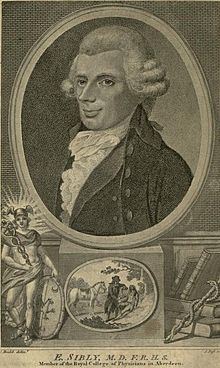Name Ebenezer Sibly | Role Physician | |
 | ||
Books A Key to Physic - and the Occult, A Complete Illustratio, The Universal Dream B, A Herbal of Foreign Plants: B | ||
Ebenezer Sibly (1751 – c. 1799) was an English physician, astrologer and writer on the occult.
Contents
Life
He was the son of a mechanic, born in Bristol, and brother of Manoah Sibly. He early devoted himself to medicine, and also to astrology. He studied surgery in London.
In 1794 he was living in Portsmouth, and became a Freemason there. In 1785 he was working as an astrologer in Bristol; and by about 1788 had moved to London. In 1790 he was temporarily in Ipswich, supporting at the general election Sir John Hadley D'Oyly, the Whig member. On 20 April 1792 he graduated M.D. from King's College, Aberdeen.
As a student of medicine, he became interested in the theories on animal magnetism of Anton Mesmer, joining Mesmer's Harmonic Philosophical School, and later also theosophy.
Sibly died in London in about 1799.
Works
Sibly is celebrated for the natal horoscope he cast of the United States of America, published in 1787 and still cited.
Translations
Ebenezer Sibly used an eclectic mixture of early modern esoteric works. His brother Manoah Sibly (1757–1840) was a linguist, as well as a Swedenborgian preacher. Under Manoah's name appeared texts including a revision of John Whalley's translation of the Tetrabiblos, and a translation of Placidus de Titis; as an astrologer, Ebenezer is said to have used the Placidian system of houses; as a student of alchemy, he translated Bernard of Treviso (the fountain allegory). It has been said that experts of the time would have seen that Sibly was not very discriminating about the sources he chose, and drew on unpublished translations that he had borrowed. He knew the Book of Enoch via Charles Rainsford.
The Complete Illustration
Sibly published the New and Complete Illustration of the Celestial Science of Astrology in four volumes, from 1784. He had completed it by the time he moved to London. The work, which had later editions under variant titles, gave details of magical procedure, and an account of the spirit world derived from Reginald Scot, in the 1665 edition of Discoverie of Witchcraft. Revised editions appeared posthumously as Astrology, A New and Complete Illustration of the Occult Sciences by Ebenezer Sibly, M.D. F.R.H.S., Embellished with Curious Copper-Plates, London (1806), and The New and Complete Illustration of the Celestial Science of Astrology (1817).
Other works
Sibly published A Key to Physic, and the Occult Sciences, in 1792.
Sibly wrote a book called Universal System of Natural History in 1794. In the book, in a form of environmental monogenism, he claimed that the White Race was the first on earth:
“We must consider white as the stock whence all others have sprung, Adam and Eve and all their posterity, till the time of the deluge were white; in the first age of the world no black nation was to be found on the face of the earth.”
Sibly believed that humans had not reached Africa until after the dispersal from the Tower of Babel, that the continent's first inhabitants had been white, and that Africans had become dark only as a result of climate.
